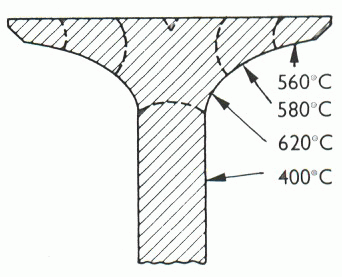Tineoidea wrote: ↑Sun Oct 22, 2023 1:30 pm
The main reason i would like full sequential is
the planned injector location. I want to install the injectors directly into the head. This has been done, and gives the injectors a nice straight shot at the intake valves
[image]
My intent here is not to "split hairs", but post general concepts. Your injector placement is fine, and should work well, generally. While the intake valve stem base is commonly the target, it should be close enough to get some useful benefit. Typically the aim is at the stem base as the area between the stem and about 2/3 to the seat edge is the hottest part of the valve.
This is the valve heat distribution. While these are exhaust valve temperatures, the intake heat distribution is similar, and temperature is not so extreme. As the heat is dissipated by the valve seat and stem, you can see the target for fuel spray:

Tineoidea wrote: ↑Sun Oct 22, 2023 1:30 pm
But placing the injector as shown has the following problem:
[image]
As you can see , some of the the injected fuel is bound to make its way torwards the intake manifold. If ran in paired injector mode, some of the fuel will puddle up in the intake. That would be my guess.
Targeting the port floor near the valve seat may not be optimal, but as it is an area the valve heat sinks, is still quite hot. And as you say, the exhaust is nearby, so it is not cold there.

It will certainly still run 'fine' as all fuel will eventually be vaporized from the walls and into the air-stream - perhaps not all of it on the on the next intake cycle, but will average across multiple upcoming cycles.

You can imagine how this would change tuning of transitions such as Accel Enrichment, if more of the fuel sticks to the walls on the next rev.
This is a good place to remind readers that injector spray angle can be important in this type of vaporization scheme. The intent is to get as much of the fuel on the hot valve for rapid vaporization as possible. A common misconception is that stock injectors firing on valves often have 'old-technology' pencil or narrow spray patterns, and switching to a wider spray or fog pattern inject or will be an improvement.
Unfortunately, this defeats the purpose of the scheme, and vaporization effectiveness and efficiency is reduced, with more fuel missing the valve and wetting the cooler walls. The tight spray patterns are intentional. Multi-hole or wide-pattern injectors are often a step backwards. Again, it will apparently run "fine", but cannot be tuned quite as efficiently as the correct injector pattern for the scheme.
Tineoidea wrote: ↑Sun Oct 22, 2023 1:30 pm
But this might be a non issue. Because the exhaust is on the same side as the intake, the manifold could get hot enough that some of the puddled up fuel will be vaporized. I am not sure about that.
There are far too many factors in fluids and dynamic flows to predict accurately, so we simply apply the best general principles we can. An example of this could be quasi-sequential, injecting twice per-cycle on each cylinder. The benefit to your injection scheme is one injection of half the fuel much earlier than the normal sequential squirt, permitting far more fuel dwell time on the hot parts.
Following is a second injection that also contains corrected fuel from data gathered in the last crank rev (corrections, acel fuel, etc). They combine to provide less lag, greater vaporization and sharper tunability, and why some OEMs are using this general scheme today. Everything is a compromise, and quasi has other concerns, such as injector size and latency (dead-time).
No, it is not necessarily "better" than another scheme, but has other advantages, such as being accurate using only paired injectors (3 INJ channels on a 6-cyl). This has other benefits in the control, wiring, and other simplifications while gaining most of full-sequential benefits and others sequential can't do.

I'm not saying to use quasi, but simply getting the info out there, as yet another example of more than one option to achieve desired results. Use the best you can for the specific application and goals. All choices are yours. Use what you can wrap your head around and is effective for
you.


